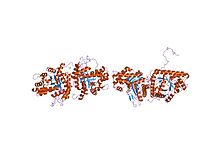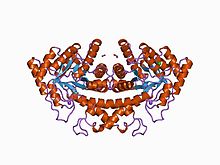Fructose-bisphosphate aldolase
 |
|||
| fructose 1,6-bisphosphate aldolase from rabbit liver | |||
| Identifiers | |||
|---|---|---|---|
| Symbol | Glycolytic | ||
| Pfam | PF00274 | ||
| InterPro | IPR000741 | ||
| PROSITE | PDOC00143 | ||
| SCOP | 1ald | ||
| SUPERFAMILY | 1ald | ||
|
|||
 |
|||
| class ii fructose-1,6-bisphosphate aldolase in complex with phosphoglycolohydroxamate | |||
| Identifiers | |||
|---|---|---|---|
| Symbol | F_bP_aldolase | ||
| Pfam | PF01116 | ||
| Pfam clan | CL0036 | ||
| InterPro | IPR000771 | ||
| PROSITE | PDOC00523 | ||
| SCOP | 1dos | ||
| SUPERFAMILY | 1dos | ||
|
|||
In molecular biology, fructose-bisphosphate aldolase EC 4.1.2.13,[1][2] is a glycolytic enzyme that catalyses the reversible aldol cleavage or condensation of fructose-1,6-bisphosphate into dihydroxyacetone-phosphate and glyceraldehyde 3-phosphate.
[edit] Classes
Two classes of fructose-bisphosphate aldolases have been described. They differ in their mechanism of catalysis:
Class I enzymes[3] are most often found in higher forms of life (animals, higher plants, ferns, mosses), do not require a metal ion, and are characterised by the formation of a Schiff base intermediate between a highly conserved active site lysine and a substrate carbonyl group.
Class II enzymes are produced in more simple forms of life, such as bacteria and a few unicellular eukaryotes (yeast), and require an active site divalent metal ion.[2] Very rarely do bacteria possess a class I enzyme, and at times do so in addition to a class II enzyme.[4]
In vertebrates, three forms of this enzyme are found: aldolase A is expressed in muscle, aldolase B in liver, kidney, stomach and intestine, and aldolase C in brain, heart and ovary. The different isozymes have different catalytic functions: aldolases A and C are mainly involved in glycolysis, while aldolase B is involved in both glycolysis and gluconeogenesis. Defects in aldolase B result in hereditary fructose intolerance.
Class II aldolases,[2] mainly found in bacteria and fungi, are homodimeric enzymes, which require a divalent metal ion, generally zinc, for their activity. The class II aldolase family of proteins also includes subfamilies containing the Escherichia coli galactitol operon protein, gatY, which catalyses the transformation of tagatose 1,6-bisphosphate into glycerone phosphate and D-glyceraldehyde 3-phosphate (EC 4.1.2.40); and E. coli N-acetyl galactosamine operon protein, agaY, which catalyses the same reaction. There are two histidine residues in the first half of the sequence of these enzymes that have been shown to be involved in binding a zinc ion.[5]
[edit] References
- ^ Perham RN (April 1990). "The fructose-1,6-bisphosphate aldolases: same reaction, different enzymes". Biochem. Soc. Trans. 18 (2): 185–7. PMID 2199259.
- ^ a b c Marsh JJ, Lebherz HG (March 1992). "Fructose-bisphosphate aldolases: an evolutionary history". Trends Biochem. Sci. 17 (3): 110–3. doi:10.1016/0968-0004(92)90247-7. PMID 1412694.
- ^ Freemont PS, Dunbar B, Fothergill-Gilmore LA (February 1988). "The complete amino acid sequence of human skeletal-muscle fructose-bisphosphate aldolase". Biochem. J. 249 (3): 779–88. PMC 1148774. PMID 3355497. http://www.pubmedcentral.nih.gov/articlerender.fcgi?tool=pmcentrez&artid=1148774.
- ^ Siebers, Bettina (31). Archaeal Fructose-1,6-bisphosphate Aldolases Constitute a New Family of Archaeal Type Class I Aldolase. doi:10.1074/jbc.M103447200. http://www.jbc.org/content/276/31/28710.full. Retrieved 24 March 2012.
- ^ Berry A, Marshall KE (February 1993). "Identification of zinc-binding ligands in the class II fructose-1,6-bisphosphate aldolase of Escherichia coli". FEBS Lett. 318 (1): 11–6. doi:10.1016/0014-5793(93)81317-S. PMID 8436219.
This article incorporates text from the public domain Pfam and InterPro IPR000741
This article incorporates text from the public domain Pfam and InterPro IPR000771